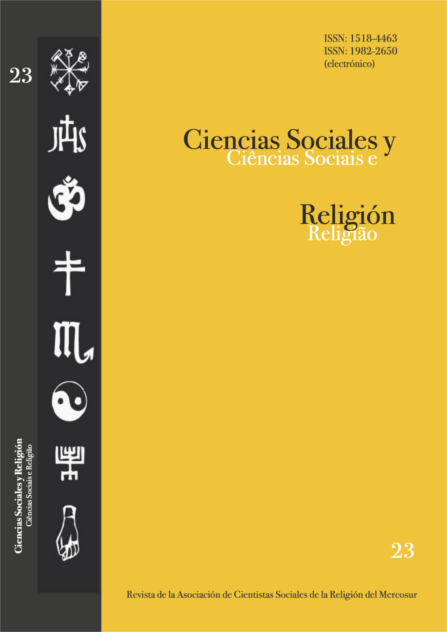Abstract
In this article we will analyze, from the geography of religion, the devotion to the "Virgen de las Nieves" in San Carlos de Bariloche through the analysis of the ex-votos. The grotto of the Virgin, located eleven kilometers from the center of the city, has been built by a soldier in fulfillment of a promise, in the army of mountain land. This Grotto is constituted as sacred territory with a particular dynamic that makes it in a devotional epicenter respect to the adjacent spaces involved in religious practice. Accordingly, we make a first characterization of the grotto of the Virgin as sacred space and symbolic place through the classification, categorization and analysis of material offerings and promises of the devotees.
References
BARELLI, Ana Inés. Las devociones marianas y los migrantes latinoamericanos en San Carlos de Bariloche (1970-2012): prácticas religiosas y procesos identitarios. Tesis de Doctorado. Universidad Nacional del Sur, 2013.
BENEDETTI, Alejandro. Territorio: concepto integrador de la Geografía contemporánea”, en: De Souto, Patricia (Coord.). Territorio, Lugar, paisaje. Prácticas y conceptos básicos en Geografía. Buenos Aires: Editorial de la Facultad de Filosofía y Letras, Universidad de Buenos Aires, 2011.
BRACE, Catherine, Bailey, Adrian and Harvey, David. Religion, place and space: a framework for investigating historical geographies of religious identities and communities. Progress in Human Geography 30,1 (2006) 28-43.
CARBALLO, Cristina.Repensar el territorio de la expresión religiosa. En: Carballo, Cristina. Cultura, territorios y prácticas religiosas. Prometeo. Buenos Aires, 2009.
DEL CASTILLO TRONCOSO, Alberto.Familia y sociedad Imágenes y representaciones en el mundo de los exvotos en México en las primeras décadas del siglo XX. Anais do Museu Paulista. São Paulo. N. Sér. v.13. n.1. p. 175-203. jan. -jun. 2005.
DELLA DORA, Verónica. Engaging Sacred Space: experiments in the Field.Journal of Geography in Higher Education, Vol.35,2,163-184,may 2011.
ESQUERDA BIFET, Juan.Diccionario de la Evangelización, Madrid, LABAC, 1998.
FOGELMAN, Patricia. Religiosidad en el Museo. Lo Sagrado en el Museo. XV Cátedra de Historia Ernesto Restrepo Tirado, Museo Nacional de Colombia, Ministerio de cultura, 2012.
GADOW REDER, Marion. El Patrimonio Inmaterial de la Cultura Cristiana,San Lorenzo del Escorial 2013, 147-158.
HADAD, Maria Gisela y Venturiello. La Virgen de Luján como símbolo de identidad popular: significaciones de una virgen peregrina, en: Dri, Rubén Símbolos y fetiches religiosos en la construcción de la identidad popular. Biblos, Buenos Aires, 2007.
MATOSSIAN, Brenda. Migración y segregación urbana en ciudades medias. Chilenos en San Carlos de Bariloche, Patagonia – Argentina. Editorial Académica Española. Berlín, 2012.
PADRINO BARRERA José M. San Antonio Abad y su culto en La Matanza de Acentejo, Revista Sans Soleil - Estudios de la Imagen, Vol 5, No 2, 2013, 138-154.
PERRÉE, Caroline, Conferencia “El exvoto: un objeto lábil cruzando la historia” en el marco del I Taller de Religión, exvotos y estudios culturales vinculado a las IV Jornadas RELIGAR-SUR / VI Jornadas de Religión y Sociedad en Argentina.
ROSENDAHL, Zeny, Hierópolis y procesiones: lo sagrado y el espacio”, en: Carballo Cristina (coord.) Cultura, territorios y prácticas religiosas. Prometeo, Buenos Aires, 2009.
SCHENONE, Héctor, Santa María. Buenos Aires, UCA, 2008.

This work is licensed under a Creative Commons Attribution-NonCommercial-ShareAlike 4.0 International License.
Copyright (c) 2020 Maria Andrea Nicoletti, Ana Inés Barelli
